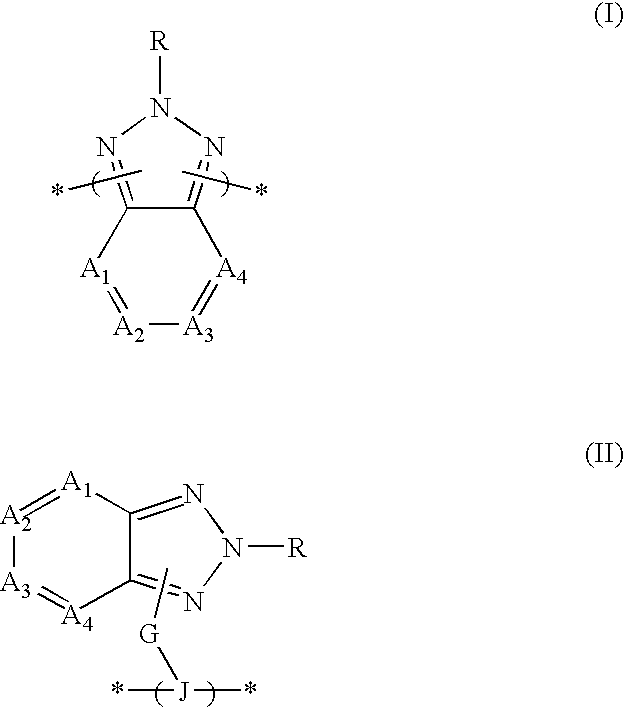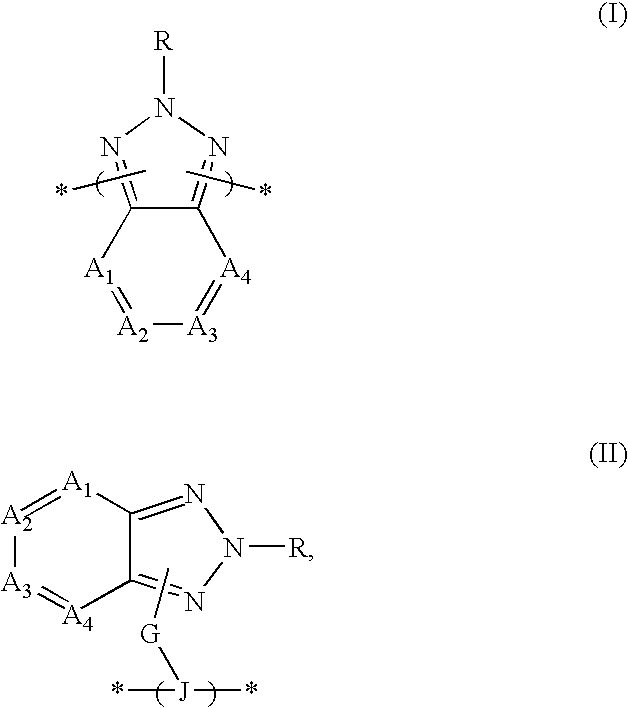New luminescent compositions and their uses
a luminescent composition and composition technology, applied in the field of organic/polymer chemistry, can solve the problems of reducing the luminescence output, severely limiting the working life of the device, and frequently degrading the organic luminescence device, and achieve the effect of high quantum yield and easy preparation
- Summary
- Abstract
- Description
- Claims
- Application Information
AI Technical Summary
Problems solved by technology
Method used
Image
Examples
example 1
2,4-Di-tert-butyl-6-(4,7-dibromo-benzotriazol-2-yl)-phenol
[0244]
[0245] Benzotriazol-2-yl-4,6-di-tert-butyl-phenol (48.6 g, 0.15 mol) was placed in a 3-neck 1-L flask equipped with a stir bar, an addition funnel, a reflux condenser, and a flow control adapter. Through a three-way connecting tube the nitrogen flow was diverted to the flask via the condenser and to an oil bubbler. The bubbler was connected to a filtration flask containing aqueous sodium hydroxide. Hydrobromic acid (45% in acetic acid, 300 mL) was added. The system was purged with nitrogen for 15 min. The slurry was heated to 110° C. for 0.5 h and bromine (23.2 mL, 0.45 mol, 3 equivalent) was added dropwise. The addition was completed in 1 h and the mixture was stirred for an additional 1 h. Three more portions of bromine (3×23.2 mL, 3×0.45 mol) were added and stirring continued for one more hour. The flask was cooled to room temperature. Water (200 mL) was added and the mixture was filtered. The solid was collected an...
example 2
2-(3,5 -di-tert-butyl-2-methoxyphenyl)-4,7-dibromo-2H-benzotriazole
[0246]
[0247] 2,4-Di-tert-butyl-6-(4,7-dibromo-benzotriazol-2-yl)-phenol (Monomer T1) (1.0 g, 2.08 mmol) and potassium carbonate (0.431 g, 96% GC purity, 3.12 mmol) were mixed in anhydrous DMF (20 mL) in a round-bottomed 100-mL flask. The flask was capped with a rubber septum and purged with nitrogen for 0.5 h. The mixture was heated to 65° C. and iodomethane (0.591 g, 4.16 mmol) was added. The mixture was stirred at 60-65° C. for 1 h. The flask was cooled to room temperature. DCM (20 mL) and water (20 mL) were added and the organic phase was separated and the aqueous phase extracted with DCM (20 mL). All the organic phases were combined and washed with water (3×20 mL) and brine (20 mL). The solution was dried over magnesium sulfate and filtered. The filtrate was evaporated to dryness with a rotary evaporator. The product was crystallized from DCM / hexanes and filtered. Purity: 99% (GC). Yield: 34%.
example 3
4,7-Dibromo-2-hexyl-2H-benzotriazole
[0248]
[0249] 1H-benzo[d][1,2,3]triazole (11.9 g, 0.10 mmol) and potassium carbonate (27.6 g, 0.20 mmol) were placed in a 250-mL round-bottom flask and purged with nitrogen. DMF (100 mL) was added and the flask was heated at 70° C. for 2 h. 1-Bromohexane (15.4 mL, 0.11 mol) was added and the suspension was stirred at 70° C. for 2 h. The solution was cooled to room temperature and DCM (200 mL) and water (200 mL) were added. The organic phase was separated and washed with water and brine. The solution was dried over magnesium sulfate and filtered. The solvent of the filtrate was removed under reduced pressure. The excess bromohexane was distilled off under high vacuum. GC / MS indicated the formation of two isomers with a ratio of ca 1:1. The mixture of the two isomers was placed in a 250-mL round-bottomed flask. Diethyl ether (50 mL) and HCl (2M in ether, 50 mL, 100 mmol) were added and the solution stirred for 15 min. The supernatant was transferred...
PUM
| Property | Measurement | Unit |
|---|---|---|
| mol % | aaaaa | aaaaa |
| mol % | aaaaa | aaaaa |
| mol % | aaaaa | aaaaa |
Abstract
Description
Claims
Application Information
 Login to View More
Login to View More - R&D
- Intellectual Property
- Life Sciences
- Materials
- Tech Scout
- Unparalleled Data Quality
- Higher Quality Content
- 60% Fewer Hallucinations
Browse by: Latest US Patents, China's latest patents, Technical Efficacy Thesaurus, Application Domain, Technology Topic, Popular Technical Reports.
© 2025 PatSnap. All rights reserved.Legal|Privacy policy|Modern Slavery Act Transparency Statement|Sitemap|About US| Contact US: help@patsnap.com



